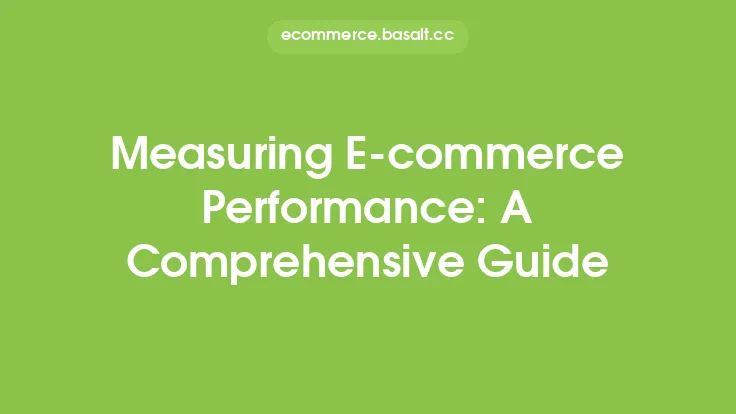Measuring the success of an e-commerce business is crucial to understanding its overall performance and identifying areas for improvement. With the vast amount of data available, it can be overwhelming to determine which metrics are most important. Key Performance Indicators (KPIs) are quantifiable measures that help e-commerce businesses evaluate their progress towards their goals. In this article, we will explore the most important KPIs for measuring e-commerce success, providing a comprehensive guide for businesses to track and analyze their performance.
Introduction to E-commerce KPIs
E-commerce KPIs are used to measure the performance of an online store, providing insights into customer behavior, sales, marketing, and operational efficiency. These metrics help businesses identify strengths and weaknesses, make data-driven decisions, and optimize their strategies to drive growth and improvement. Common e-commerce KPIs include conversion rates, average order value, customer lifetime value, and customer retention rates. By tracking these metrics, businesses can gain a deeper understanding of their customers' needs and preferences, ultimately leading to increased sales and revenue.
Sales and Revenue KPIs
Sales and revenue KPIs are essential for measuring the financial performance of an e-commerce business. These metrics include:
- Conversion rate: The percentage of website visitors who complete a purchase.
- Average order value (AOV): The average amount spent by customers in a single transaction.
- Sales revenue: The total amount of revenue generated from sales.
- Gross margin: The difference between revenue and the cost of goods sold.
- Return on investment (ROI): The return on investment for marketing campaigns and other business expenses.
By tracking these KPIs, businesses can identify trends and patterns in customer purchasing behavior, optimize pricing strategies, and improve overall revenue growth.
Customer KPIs
Customer KPIs are critical for understanding customer behavior and preferences. These metrics include:
- Customer acquisition cost (CAC): The cost of acquiring a new customer.
- Customer lifetime value (CLV): The total value of a customer over their lifetime.
- Customer retention rate: The percentage of customers who return to make repeat purchases.
- Customer satisfaction (CSAT): A measure of customer satisfaction with their shopping experience.
- Net promoter score (NPS): A measure of customer loyalty and satisfaction.
By tracking these KPIs, businesses can identify opportunities to improve customer satisfaction, reduce churn rates, and increase customer loyalty.
Marketing KPIs
Marketing KPIs are used to measure the effectiveness of marketing campaigns and strategies. These metrics include:
- Website traffic: The number of visitors to an e-commerce website.
- Social media engagement: The level of engagement with social media content.
- Email open rates: The percentage of email recipients who open marketing emails.
- Click-through rates (CTR): The percentage of website visitors who click on marketing links.
- Conversion rates: The percentage of website visitors who complete a desired action.
By tracking these KPIs, businesses can optimize their marketing strategies, improve campaign effectiveness, and increase return on investment.
Operational KPIs
Operational KPIs are used to measure the efficiency and effectiveness of e-commerce operations. These metrics include:
- Order fulfillment rate: The percentage of orders fulfilled on time.
- Shipping time: The time it takes for orders to be shipped and delivered.
- Inventory turnover: The number of times inventory is sold and replaced within a given period.
- Return rate: The percentage of orders returned by customers.
- Customer service response time: The time it takes for customer service teams to respond to customer inquiries.
By tracking these KPIs, businesses can identify areas for improvement in their operational processes, reduce costs, and improve customer satisfaction.
Analyzing and Acting on E-commerce KPIs
Analyzing and acting on e-commerce KPIs is crucial for driving business growth and improvement. Businesses should regularly review their KPIs, identifying trends and patterns, and making data-driven decisions to optimize their strategies. This may involve:
- Segmenting customer data to identify high-value customer groups.
- Optimizing marketing campaigns to improve conversion rates and return on investment.
- Improving operational processes to reduce costs and improve customer satisfaction.
- Identifying areas for improvement in customer service and support.
By taking a data-driven approach to e-commerce, businesses can drive growth, improve customer satisfaction, and stay ahead of the competition.
Best Practices for Tracking E-commerce KPIs
To get the most out of e-commerce KPIs, businesses should follow best practices for tracking and analyzing their data. These include:
- Setting clear goals and objectives for KPI tracking.
- Using a range of data sources, including website analytics, customer feedback, and social media insights.
- Regularly reviewing and updating KPIs to ensure they remain relevant and effective.
- Using data visualization tools to present complex data in a clear and concise manner.
- Making data-driven decisions, rather than relying on intuition or anecdotal evidence.
By following these best practices, businesses can ensure they are getting the most out of their e-commerce KPIs, and driving growth and improvement in their online store.





